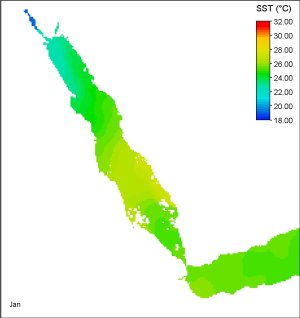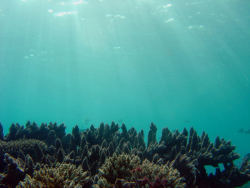What do corals need?
Many organisms are restricted to a particular geographical area by the surrounding physical environment. For example, polar bears are highly adapted to cold Arctic conditions and would struggle to survive in the deserts of the Sahara. Corals suffer under the same restrictions; they are possibly restricted to local areas with specific characteristics. That's why they only cover 0,2% of the ocean floor.
Corals like it hot… but not too hot!
Temperature is one of the most important limiting factors. Their distribution on earth shows that corals need a relatively high sea temperature, between approximately 18 and 30°C. This explains their occurrence between 30°N and 30°S around the equator.
Temperature is thus responsible for the horizontal spatial distribution of coral reefs in the world. In the animation below, you can see how the sea surface temperature (SST) changes throughout the year.

Source: Ghent University.
More salt, please!
Globally, corals occur in a salinity range between 32 and 40 PSU (practical salinity units), although coral reefs also thrive in exceptionally high and low salinity conditions. More important than average salinity concentrations, however, are sudden decreases in salinity due to high freshwater input by rivers or torrential rains. Decreased salinity is seen as a second factor for the disappearance of massive coral reefs in front of large river mouths.
Turn on the light!
As temperature limits the horizontal distribution, light is responsible for the vertical distribution, i.e. depth.
Because light is primordial for photosynthesis by the symbiotic algae, corals are restricted to clear, shallow water. The less light they receive, the more fragile the coral skeletons will be, so breakage of the corals will occur much easier. Receiving sufficient light depends on the incoming solar irradiation at the water surface and water transparency.

Corals generally occur up to a depth of 40 to 60 m, although some have been reported to occur at depths of 100 m and more in exceptionally clear waters. Coral growth below this depth becomes impossible or severely restricted.
Don't push too much!
Currents are responsible for the distribution of coral larvae over short to long distances. Sufficient wave
action is necessary to provide food and oxygenated water to the sedentary polyps, to prevent smothering of the polyps by sediments
and to remove waste products from the coral system.
Too strong waves and currents, conversely, may prohibit or inhibit reef formation.
- temperature
- salinity
- light
- ocean waves and currents
